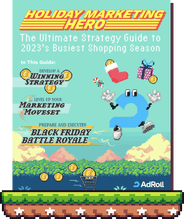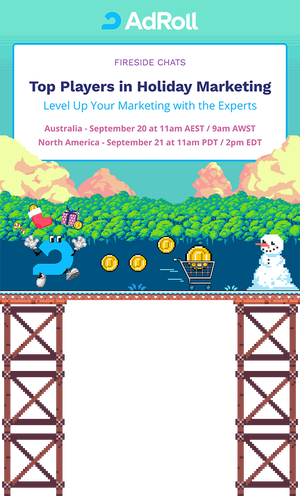6 Simple Ways to Drive Holiday Shopping Conversions
The year is finally coming to a close. The busiest shopping season is only just beginning. Here’s 6 tips to convert holiday shoppers.
Read More
The race to holiday revenue is on! Complete each level to generate brand awareness, maximize budget, and create a campaign your customers can’t ignore.



The ultimate strategy guide to 2023’s busiest shopping season

Most shoppers won’t start thinking about the holidays until late fall. But for many businesses, the most wonderful time of the year starts now.
The average customer requires 56 touchpoints before making a purchase, which means marketers need to get in front of ideal shoppers months before peak shopping season. Don’t know where or how to begin? We’ll walk you through each month of holiday marketing prep, execution, and follow-up to keep you on track to crush your 2023 goals.
For marketers, navigating the holiday shopping season is a lot like playing a video game: You define your mission, set your strategy, and journey toward the finish line while overcoming obstacles.
With the right planning, skills, and a little help from experts along the way, you can beat the game — which means more revenue and a stronger business foundation for the coming year.
Watch our North American and Australian webinars that bring together marketing experts from AdRoll, Duckfeet USA, Onewheel, Searchspring, and Yotpo to share their "cheat codes" to win the holiday shopping season.


You know big dates like Black Friday and Christmas, but what about all the important events that happen before or in between? Use our holiday marketing calendar to prepare for key milestones and stay organized through 2023 and beyond.
| Sun | Mon | Tue | Wed | Thu | Fri | Sat |
|---|---|---|---|---|---|---|
| 1 | 2 | 3 | 4 | 5 | ||
| 6 | 7 | 8 | 9 | 10 | 11 | 12 |
| 13 | 14 | 15 | 16 | 17 | 18 | 19 |
| 20 | 21 | 22 | 23 | 24 | 25 | 26 |
| 27 | 28 | 29 | 30 | 31 |
| Sun | Mon | Tue | Wed | Thu | Fri | Sat |
|---|---|---|---|---|---|---|
| 1 | 2 | |||||
| 3 Labor Day | 4 | 5 | 6 | 7 | 8 | 9 |
| 10 | 11 | 12 | 13 | 14 | 15 | 16 Rosh Hashanah |
| 17 Rosh Hashanah | 18 | 19 | 20 | 21 | 22 | 23 |
| 24 | 25 Yom Kippur | 26 | 27 | 28 | 29 | 30 |
| Sun | Mon | Tue | Wed | Thu | Fri | Sat |
|---|---|---|---|---|---|---|
| 1 | 2 | 3 | 4 | 5 | 6 | 7 |
| 8 | 9 Indigenous Peoples' Day | 10 | 11 | 12 | 13 | 14 |
| 15 | 16 | 17 | 18 | 19 | 20 | 21 |
| 22 | 23 | 24 | 25 | 26 Eid Milad ul-Nabi | 27 | 28 |
| 29 | 30 | 31 Halloween |
| Sun | Mon | Tue | Wed | Thu | Fri | Sat |
|---|---|---|---|---|---|---|
| 1 | 2 | 3 | 4 | |||
| 5 | 6 | 7 | 8 | 9 | 10 | 11 Veterans Day |
| 12 Diwali | 13 | 14 | 15 | 16 | 17 | 18 |
| 19 | 20 | 21 | 22 | 23 Thanksgiving Day | 24 Black Friday | 25 Small Business Saturday |
| 26 | 27 Cyber Monday | 28 | 29 | 30 |
| Sun | Mon | Tue | Wed | Thu | Fri | Sat |
|---|---|---|---|---|---|---|
| 1 | 2 | |||||
| 3 | 4 | 5 | 6 | 7 | 8 Hanukkah Begins | 9 |
| 10 | 11 | 12 | 13 | 14 | 15 Hanukkah Ends | 16 |
| 17 | 18 | 19 | 20 | 21 | 22 | 23 |
| 24 Christmas Eve | 25 Christmas Day | 26 Kwanzaa Begins | 27 | 28 | 29 | 30 |
| 31 New Year's Eve |
| Sun | Mon | Tue | Wed | Thu | Fri | Sat |
|---|---|---|---|---|---|---|
| 1 New Year's Day Kwanzaa Ends | 2 | 3 | 4 | 5 | 6 | |
| 7 | 8 | 9 | 10 | 11 | 12 | 13 |
| 14 | 15 Martin Luther King, Jr. Day | 16 | 17 | 18 | 19 | 20 |
| 21 | 22 | 23 | 24 | 25 | 26 | 27 |
| 28 | 29 | 30 | 31 |

Discover additional holiday marketing strategies, insights, and guides to make this season your best yet. 🎁
The year is finally coming to a close. The busiest shopping season is only just beginning. Here’s 6 tips to convert holiday shoppers.
Read More
Whether your brand is sentimental, sarcastic, or something in between, there’s a way to make your holiday campaigns stand out this season. Click here to see 4 inspiring examples.
Read More
TikTok’s Shopping ads are a powerful ad format that can help you unlock the audience you need to make this holiday season. Click here to get the step-by-step.
Read More
Drive great results this holiday season with these holiday email marketing tips to help you plan and launch a successful campaign.
Read More
Black Friday and Cyber Monday are the star holidays of the season, but they’re not the ONLY holidays. Here are lesser known holidays for your business to celebrate this year.
Read More
Want to make sure you have eager holiday shoppers on your site or in your store? Start building your brand awareness now! Click here to learn more about holiday brand awareness.
Read More
